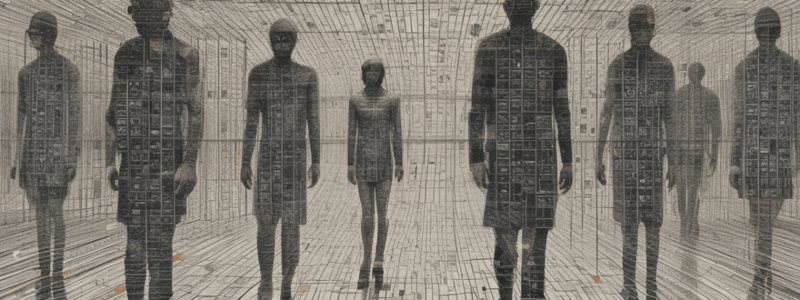Podcast
Questions and Answers
What is the primary purpose of extracting features from images in classification tasks?
What is the primary purpose of extracting features from images in classification tasks?
- To convert the images into a different color scheme
- To handle variations like scale, shift, and rotation (correct)
- To directly compare the black and white images
- To resize the images for better classification accuracy
Why can't we classify X's by directly comparing the whole black and white images?
Why can't we classify X's by directly comparing the whole black and white images?
- Because the images need to be resized first
- Because the images are represented by different colors
- Because there is too much variation between the classes (correct)
- Because the images are in black and white
What is meant by features in the context of image classification?
What is meant by features in the context of image classification?
- Different sizes of the black and white images
- Important parts of an image being analyzed (correct)
- The file format of the images
- Colors used in representing the images
What does the term 'invariant' refer to in relation to image classification?
What does the term 'invariant' refer to in relation to image classification?
How are features represented within an image for classification purposes?
How are features represented within an image for classification purposes?
What do filters help with in terms of image features during classification?
What do filters help with in terms of image features during classification?
What is the main purpose of capturing features in terms of the arms, legs, and body of the X?
What is the main purpose of capturing features in terms of the arms, legs, and body of the X?
What do the smaller matrices mentioned in the text represent?
What do the smaller matrices mentioned in the text represent?
What does convolution preserve between pixels while learning image features?
What does convolution preserve between pixels while learning image features?
What operation is performed when a patch is placed on top of an input image?
What operation is performed when a patch is placed on top of an input image?
What is the result of element wise multiplication when there is perfect overlap between a filter and an image patch?
What is the result of element wise multiplication when there is perfect overlap between a filter and an image patch?
What is the final step after performing element wise multiplication when applying convolution to an image patch?
What is the final step after performing element wise multiplication when applying convolution to an image patch?
Study Notes
Image Classification and Feature Extraction
- Extracting features from images enhances classification accuracy by focusing on essential characteristics rather than analyzing entire images.
- Directly comparing whole black and white images is inefficient due to high dimensionality and irrelevant pixel variations, hindering effective classification.
Features in Image Classification
- Features refer to distinct attributes or patterns within an image (e.g., edges, textures) that can be used to differentiate between classes.
- Invariance pertains to the ability to recognize an object regardless of changes in perspective, scale, or lighting during classification.
Representation of Features
- Features are often represented using numerical values in a lower-dimensional space, facilitating easier processing and categorization.
- Filters are algorithms that extract specific features by highlighting important patterns while minimizing unnecessary data.
Purpose of Capturing Features
- Capturing features related to limbs and body parts aids in object recognition and differentiation, enhancing model performance and accuracy.
Small Matrices and Convolution
- Smaller matrices, known as filters or kernels, represent localized patterns of the original image, allowing detection of specific features.
- Convolution preserves spatial relationships between pixels while learning image features, maintaining the context of the relationships during analysis.
Convolution Process
- An operation called convolution is performed when a filter is applied to an image patch, enabling feature extraction.
- Element-wise multiplication yields a high value when there is perfect overlap between a filter and an image patch, indicating strong feature presence.
Final Steps in Convolution
- After element-wise multiplication, a summation of the results produces a single pixel value, which is used in the output feature map for further classification analysis.
Studying That Suits You
Use AI to generate personalized quizzes and flashcards to suit your learning preferences.
Description
Learn how to classify images of X's using black and white representations. Explore how to extract features from images and understand the challenges in comparing matrices of different classes.




